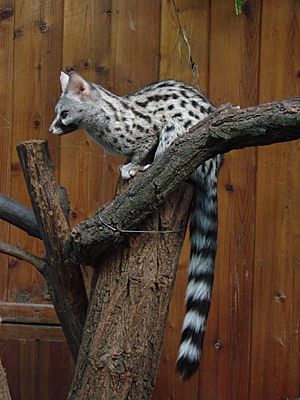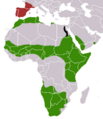Common genet facts for kids
Quick facts for kids Common genet |
|
|---|---|
 |
|
| Conservation status | |
| Scientific classification | |
| Genus: |
Genetta
|
| Species: |
genetta
|
 |
|
| Common genet range (green – native, red – extant introduced, black – extinct introduced) |
|
| Synonyms | |
|
Viverra genetta (Linnaeus, 1758) |
|
The common genet (Genetta genetta) is a small, cat-like animal from Africa. It was also brought to southwestern Europe. You can find it in many parts of Africa, like north of the Sahara Desert and in the grassy savannas south of it. It also lives along the coasts of Arabia, Yemen, and Oman. Scientists say it's not currently in danger of disappearing, so it's listed as 'Least Concern'.
Contents
What Does a Common Genet Look Like?
The common genet has a slim, cat-like body. It has a small head with a pointed nose and large, oval ears. Its eyes are big, and its whiskers can be up to 7 centimeters long.
Its legs are short, with feet like a cat's. It has claws that can mostly pull back, similar to a cat. Its fur is thick and soft, usually pale grey with many black spots. There are about five rows of black spots on its back and sides. A long black stripe runs down its back from its shoulders to its tail.
It also has a black stripe on its forehead. Dark patches are found under its eyes, which stand out against the white fur on its chin and throat. Its tail is striped with 8 to 13 rings. The genet's body is 43 to 55 centimeters long, and its tail is 33 to 52 centimeters long. Males are usually about 10% bigger than females, weighing around 2 kilograms. It has a crest of hair on its back that can stand up. Its tail tip is white, and its back feet are black.
Sometimes, a common genet can be completely black. One such animal was seen in southern Portugal in 2019.
Where Do Common Genets Live?
In North Africa, common genets live along the western Mediterranean Sea coast. They also live in a wide band from Senegal to Mauritania in the west. This band stretches through the savannah zone south of the Sahara Desert to Somalia and Tanzania in the east.
On the Arabian Peninsula, they have been seen in coastal areas of Saudi Arabia, Yemen, and Oman. Another group lives in Southern Africa, from southern Angola across Zambia, Zimbabwe, to Mozambique.
Common genets live in many different types of places. They like areas with lots of shelter, like rocky places with caves or thick bushes. They can also live close to towns and farms. They are common in Morocco and Algeria. However, they are rare in Libya, Egypt, and Zambia.
Common genets were brought to the Mediterranean region from North Africa about 1,000 to 1,500 years ago. They spread from Spain to the Balearic Islands and southern France. In Europe, they prefer oak and pine forests. They also live in olive groves, along rivers, in rocky areas, and in shrublands. They don't often live in open fields or marshes.
They prefer areas with thick plants, like bushes and dense forests. For resting, they use trees with lots of leaves or thick bushes with climbing plants. In northern areas, they like lower places that are warmer and don't get much rain. In central Spain, they live in rocky areas with many shrubs. They don't mind being near human settlements.
How Do Common Genets Behave?
Common genets are usually solitary animals, meaning they live alone. Adult genets are mostly active at night and during twilight (dawn and dusk). They are most active right after sunset and just before sunrise. Young genets might be active during the day.
They rest during the day in hollow trees or among thick bushes. They often use the same resting spots. In southern Spain, adult genets have a home range of about 7.8 square kilometers. The home ranges of males and females can overlap. However, the ranges of genets of the same sex usually do not overlap.
Males tend to be more active at night than females. This is because their larger size means they need more energy. Females are generally less active and have smaller home ranges. Males' home ranges are larger in all seasons, especially in winter. Their home ranges get a bit bigger in spring as they become more active, looking for a mate.
Both male and female genets mark their home ranges with scent. Females use scent glands on their sides, hind legs, and a special area near their tail. Males mark less often than females. They often spray urine instead of using scent glands, especially during the breeding season. These scent marks help genets know about the other genets in the area. Common genets also go to the bathroom in specific spots, often at the edge of their territory. These spots also act as scent markers.
Common genets make five different sounds to communicate. A "hiccup" sound means friendly interactions. Males use it during mating, and females use it to call their young. Baby genets purr in their first week. As they grow, they might moan or mew. When they learn to hunt, they growl during aggressive moments. Genets also make a "click" sound as a warning. When they feel threatened, they raise the dark stripe of hair on their back. They might also arch their back, open their mouth, and show their teeth.
What Do They Eat?
Common genets eat many different things. Their diet includes small mammals, lizards, birds, bird eggs, amphibians, centipedes, millipedes, scorpions, insects, and fruits like figs and olives. The wood mouse is one of their favorite foods. They also hunt red squirrels and dormice. Genets find their prey mostly by smell. They kill their prey with a bite to the neck, just like cats. Small rodents are caught by the back and killed with a bite to the head.
Who Hunts Them?
In Africa, common genets can be hunted by African leopards, servals, caracals, honey badgers, and large owls. Other possible hunters include the red fox and the Eurasian goshawk.
How Do They Have Babies?
In Spain, common genets have babies between January and September. The busiest times are February, March, and during the summer. Scientists have studied how they mate and how their young grow in animals kept in zoos.
After being pregnant for 10 to 11 weeks, a female can give birth to up to four young. Newborn genets weigh between 60 and 85 grams. They start eating meat around seven weeks old. They are fully weaned (stop drinking milk) at four months old. By five months old, they are good at hunting on their own. They start marking their territory when they are 19 months old. They are thought to be old enough to have their own babies at two years old. Common genets in zoos have lived for up to 13 years.
Are Common Genets in Danger?
There are no major threats to common genets right now. In North Africa and some parts of southern Africa, people hunt them for their fur. In Portugal, they sometimes get caught in traps meant for other animals. On the island of Ibiza, building new homes and roads can cause them to lose their natural living spaces.
How Are They Protected?
The common genet is listed in Appendix III of the Bern Convention. This means it is a protected species. It is also in Annex V of the Habitats and Species Directive of the European Union, which helps protect its natural habitats.
Types of Common Genets
The scientific name Viverra genetta was first given by Carl Linnaeus in 1758.
There are many different types of common genets, called subspecies. Here are some of the main ones:
- G. g. genetta (Linnaeus), 1758 – found in Spain, Portugal, and France
- G. g. afra (Cuvier), 1825 – found in North Africa
- G. g. senegalensis (Fischer), 1829 – found in Africa south of the Sahara Desert
- G. g. dongolana (Hemprich and Ehrenberg), 1832 – found in Arabia
Scientists have also reclassified the Genetta felina as its own species. They did this by comparing many different genet specimens in museums. Genets, along with other similar animals called viverrids, are thought to be very similar to the ancient ancestors of all modern meat-eating mammals.
Images for kids






